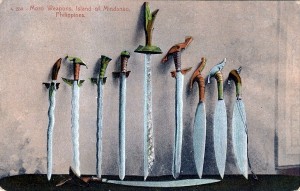
The Moro Kris The kris is the most famous Moro weapon. Variations are found in every Moro tribe and it was a key symbol of a man’s status and rank in society as well as being a powerful talisman. Kris blades are wide at the base, double-edged, and can be waved, half-waved half-straight, or straight (straight blades were more practical in combat). Older kris had fewer waves and the waves were deeper and wider. Over time the waves became shallower, tighter, and more numerous and therefore required greater skill to prevent the blade bouncing off or being stuck in an enemy’s body. The higher number of waves meant the more potent the kris was in talismanic power. Sometimes engravings (often filled in with brass or silver inlay) are found on the blade in plant motifs (vines, foliage, etc.) or Arabic script. Many kris blades are forged with fullers. Moro kris are cutting and slashing swords versus the stabbing keris of the Malay and Indonesians. Kris range from 45 to 65 centimeters (18 to 26 inches) in length. Older kris before the 19th century tended to be smaller in size. Laminated steel patterns are sometimes evident. Opposite the hook like fretwork on the guard of the blade is a cavity in the form of an elephant, eagle, or mouth of a naga (a mythical snake). Hilts of krises are either straight or slightly curved. Commonly the pommel is in the form of a horse hoof, or a stylized cockatoo head with beak and crest. Usually the pommel is made of hardwood burl with the handle being wrapped in lacquered fiber. Upper-class kris pommels are often made of ivory, silver, brass, or other exotic materials with handles wrapped in chased bands of silver or swassa (copper-gold alloy) or braided wire. Large extravagant cockatoo pommels appeared toward the end of the 19th century and are called junggayan. Pommels before the 19th century were very small. Moro kris scabbards were made of wide grain native hardwoods like mahogany, teak, and narra, lashed together with rattan or metal strips. Sometimes the crosspiece is separate from the bottom, but more often they are carved together. Around the mid-20th century mother-of-pearl was introduced to scabbard work and kris pommels. Scabbards of the nobility are bound with bands of plain or chased silver, brass, or swassa instead of rattan bindings. Some nobility scabbards even have crosspieces made of ivory or horn. ----- There are two types of kris used by the Moros of the Philippines. Kalis is the name used by the Tausugs, Samals and Yakans. In the Mindanao it is called Sundang and is used by the Maranaos, Maguindanos and others. The Moro kris belongs to larger family of kris found in South East Asia: Indonesia, Borneo, Malaysia and part of Thailand. Its origin is mostly likely East Java near Yogya and Solo. The Moro kris has the most varied design and style amongst the bladed weapons found in the Philippines. The Moro Kris evolved from use in combat. The double edge blade is an advantage where there are numerous opponents, the blade can be used to cut in an upward stroke. A single edge blade in contrast , needs to be turned in the opposite direction to do the same cut. The Moro kris is highly regarded by the people of Mindanao and Sulu. It is used as a symbol of authority and prestige. Kris From Wikipedia The kris or keris is an asymmetrical dagger indigenous to Indonesia, Malaysia, Singapore, Thailand and Brunei. It is known as kalis in the southern Philippines. The kris is famous for its distinctive wavy blade, but many have straight blades as well. Both a weapon and spiritual object, kris are often considered to have an essence or presence, with some blades possessing good luck and others possessing bad. In 2005, UNESCO gave the title Masterpiece of the Oral and Intangible Heritage of Humanity to the kris of Indonesia. In return, UNESCO urged Indonesia to preserve their heritage Etymology The origin of the word kris derived from the old Javanese term ngiris which means to stab, wedge or sliver. "Kris" is the more frequently-used spelling in the West, but "keris" is more popular in the dagger's native lands,[2] as exemplified by the late Bambang Harsrinuksmo's popular book entitled Ensiklopedi Keris (Keris Encyclopedia). Two notable exceptions are the Philippines, where it is usually called kalis or kris, and Thailand where it is always spelled and pronounced as kris. Other spellings used by European colonists include "cryse", "crise", "criss", "kriss" and "creese". Origins Kris depicted on Borobudur bas-relief. Kris display Kris history is generally traced through the study of carvings and bas-relief panels found in Southeast Asia. It is widely believed by archaeologists that the earliest kris prototype can be traced to Dong Son in Vietnam circa 300 BC. From there, the design would have been brought into present-day Malaysia by Cham migrants who made their way into the Malay Peninsula twenty centuries ago. Another theory is that the … [Read more...]
















